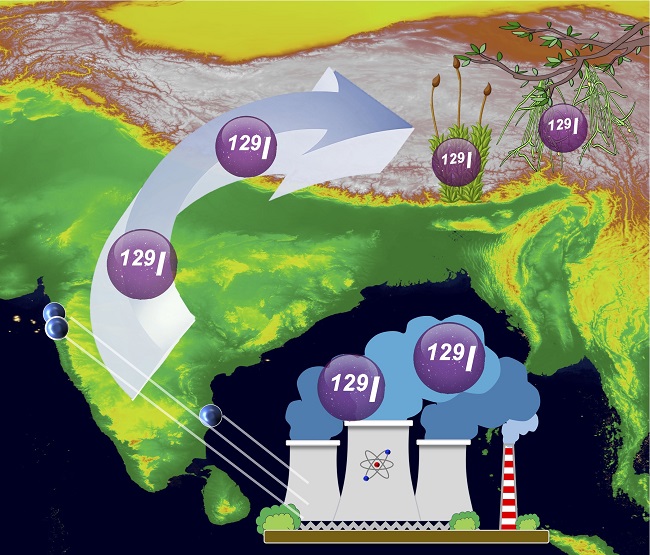Anthropogenic Iodine Isotope Uncovers Indian Nuclear Facilities Have Radioactive Influence on the Southern Tibetan Plateau
A recent work published as a supplementary cover on Environmental Science & Technology Letter, has shed light on long-range transboundary transport of radioactive iodine-129 (129I) from the Indian nuclear fuel reprocessing plants (NFRPs) to the southern Tibetan Plateau (STP). This work adds a new understanding on transport of airborne radioactive pollutants from low to high elevations, and may address the ecological environmental protection on the Tibetan Plateau.
The Tibetan Plateau, known as the "Third Pole of the earth" and the "Roof of the World", stands as a remote, isolated region presumed to be pristine. Previous studies on the radioactive contaminations have predominately focused on the northern TP, leaving scant knowledge in the southern TP (STP). Primarily originating from human nuclear activities, with the its properties of high volatility and radiation risk of short-lived radioiodine, iodine-129 serves as a pivotal radionuclide for monitoring nuclear environmental safety.
The research group of nuclear environment safety and tracing from the Institute of Earth Environment of the Chinese Academy of Sciences (CAS) has meticulously investigated the spatial variation of 129I in the bioindicators, moss and lichen, from the STP. The results unveiled that 129I in the STP were markedly higher than the pre-nuclear levels and those in Chinese inland cities, but 2-4 orders of magnitude lower than those in vicinity of the Indian and European NFRPs. Analysis of 129I discharge history in conjunction with wind field indicates that Indian NFRPs are the primary sources of 129I in the STP. The prevailing ISM plays a crucial role in the transmission of 129I from the lowland to the high-elevation STP. The transport process is further enhanced by the summertime overlaying heat pump, but is weakened by topographic block, forest adsorption, and cold trapping. The spatial distribution of 129I and 127I in lichens distributed across Mt. Galongla reveals that the Yarlung Zangbo Grand Canyon serves as a key transport channel.
“It is much out of our expectation that Indian NFRPs have such signigicant influence on the Tibet Plateau. Since there are many nuclear facilities in operation and under construction in Indian, the radioation risk is just there. So, wee still need more data to figure out the extent and scope of such impact.” Said Dr. ZHANG, the corresponding author of this work.

Fig.1 Radioactive iodine-129 released from India's nuclear fuel reprocessing plants are transported to the southern Qinghai-Tibet Plateau through long-range transboundary transport (Image by ZHANG, et al)

Fig. 2 Iodine isotope levels in mosses and lichens from the southern Tibetan Plateau and their comparison with other sites of the world and India (Image by ZHANG, et al)
This work was supported by the second comprehensive scientific expedition to the Qinghai-Tibetan Plateau, Chinese Academy of Sciences and the National Natural Science Foundation of China.
Contact: BAI Jie, Institute of Earth Environment, Chinese Academy of Sciences, Xi'an, China. Email: baijie@ieecas.cn
 © 2015 Institute of Earth Environment,CAS
© 2015 Institute of Earth Environment,CAS Address:No. 97 Yanxiang Road, Xi'an 710061, Shaanxi, China

 Location :
Location :